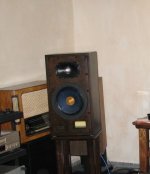I bought a 9"and supposedly a SOTA woofer (Vienna acoustics ) used in some $17k speakers (Klimt) and its measured QTC is around 1.5 or so . I was trying to figure out the design objectives behind that design....
Profit?
I don't think so. The speaker garnered some excellent reviews and it is supposedly a SOTA design in it's class .Profit?
The Rehedko speakers I have and like quite a bit have the same kind of 10" woofer. 1.3 Qts and 105 Hz Fs .
It is a fringe movement in the speaker design I assume .
Attachments
Last edited:
Sometimes a less 'perfect' loudspeaker is preferable by the manufacturers an the listeners too, this depends on more things.I don't think so. The speaker garnered some excellent reviews and it is supposedly a SOTA design in it's class .
The Rehedko speakers I have and like quite a bit have the same kind of 10" woofer. 1.3 Qts and 105 Hz Fs .
It is a fringe movement in the speaker design I assume .
If we take a close look, it turns out that a very few manufacturers use textbook 'optimal' bass alignments for their commercial loudspeakers.
Of course, there are many counter-examples.
Of course, there are many counter-examples.
Exactly. The acoustic alignment hasn't changed, and the system will follow that to every external -- to the drive signal -- exitation (including the woofer's own distortion, overload recovery etc). The only way to change it would be using an amp with some negative output impedance.But the box still rings at its inherent frequency and Q from any stimulation that may come its way, in the pure sound signal or otherwise.
But, a system Q of 1.5 is still quite benign and considered as reasonably well-damped and pre-correction via EQ will work well with little additional side-effects. Once you get above a Q of 3...4 things start to get ugly and pre-correction starts to get sensitive to dynamic parameter shifts.
